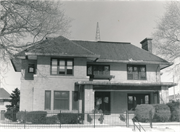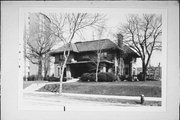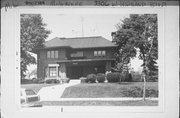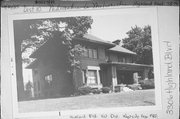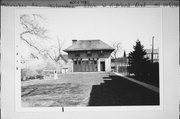Property Record
3306 W HIGHLAND BLVD
Architecture and History Inventory
| Historic Name: | Weinhagen, George House |
|---|---|
| Other Name: | |
| Contributing: | Yes |
| Reference Number: | 27889 |
| Location (Address): | 3306 W HIGHLAND BLVD |
|---|---|
| County: | Milwaukee |
| City: | Milwaukee |
| Township/Village: | |
| Unincorporated Community: | |
| Town: | |
| Range: | |
| Direction: | |
| Section: | |
| Quarter Section: | |
| Quarter/Quarter Section: |
| Year Built: | 1911 |
|---|---|
| Additions: | |
| Survey Date: | 1984 |
| Historic Use: | house |
| Architectural Style: | Prairie School |
| Structural System: | Balloon Frame |
| Wall Material: | Brick |
| Architect: | Herman W. Buemming |
| Other Buildings On Site: | |
| Demolished?: | No |
| Demolished Date: |
| National/State Register Listing Name: | Highland Boulevard Historic District |
|---|---|
| National Register Listing Date: | 7/30/1985 |
| State Register Listing Date: | 1/1/1989 |
| National Register Multiple Property Name: | Multiple Resources of West Side Area |
| Additional Information: | A 'site file' exists for this property. It contains additional information such as correspondence, newspaper clippings, or historical information. It is a public record and may be viewed in person at the State Historical Society, Division of Historic Preservation. Debbink was the builder and Hoeppner was the mason. A garage at 3306A W. Highland Boulevard is a related building (MI 108/16). Another map code is 19/20 LUQS #388. Goerge Weinhagen was the Vice President and Treasurer of The Goerge Schultz Company which manufactures paper and boxes. George Weinhagen's brick mansion is Milwaukee's largest Prairie-style house. Prairie style was the most fashionable avant-garde architecture of its period, and the Weinhagen House features its restrained use of ornament, a long, low roofline with broad fascia, extra-wide overhangs, continuous window rows, Roman brick, and an overall horizontal emphasis. The carriage house was designed to match the main building. West Highland Boulevard was one of Milwaukee's exclusive residential thoroughfares when George Weinhagen built his house. Its appearance resulted from the Milwaukee Common Council’s innovative city planning. In 1896, the council designated that stretch of West Highland Avenue as a grand parkway, creating a forty-foot-wide landscaped esplanade and banning freight traffic. City created similar boulevards along McKinley and Newberry Avenues. These parkways beautified the densely packed city, giving residents breathing room, and encouraging upper-class residential construction. The breadth of West Highland Boulevard attracted wealthy families, who purchased spacious lots and hired local architects such as Herman Buemming, Carl Barkhausen, and Ferry and Clas to design their high-style houses. So many German Americans moved there that West Highland became known as "Sauerkraut Boulevard." George Weinhagen was born in 1859, in Hildesheim in northwest Germany, and came to Milwaukee at the age of fifteen. Three years later he began a long career as the co-owner of a successful box-making business. After he died, his grand mansion became a fraternity house, and has recently been rehabilitated as an office building. |
|---|---|
| Bibliographic References: | MILWAUKEE HISTORIC BUILDINGS TOUR: WEST END, CITY OF MILWAUKEE DEPARTMENT OF CITY DEVELOPMENT, 1994. Buildings of Wisconsin manuscript. |
| Wisconsin Architecture and History Inventory, State Historic Preservation Office, Wisconsin Historical Society, Madison, Wisconsin |

